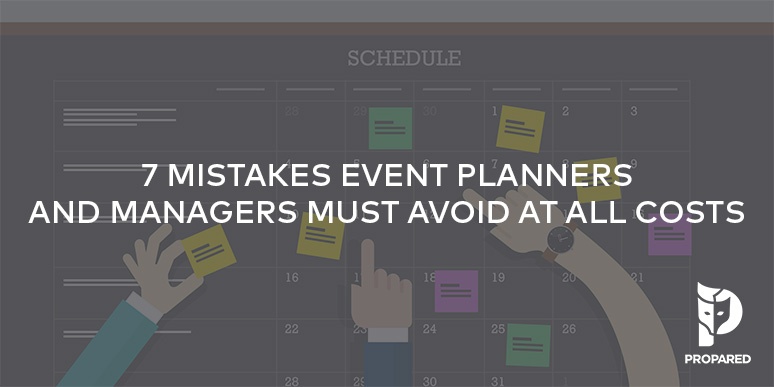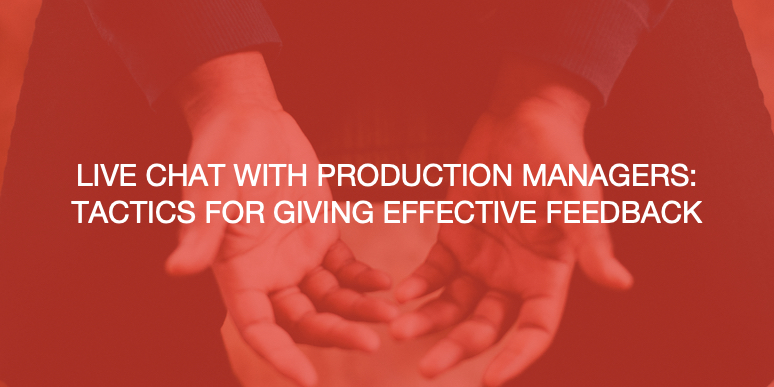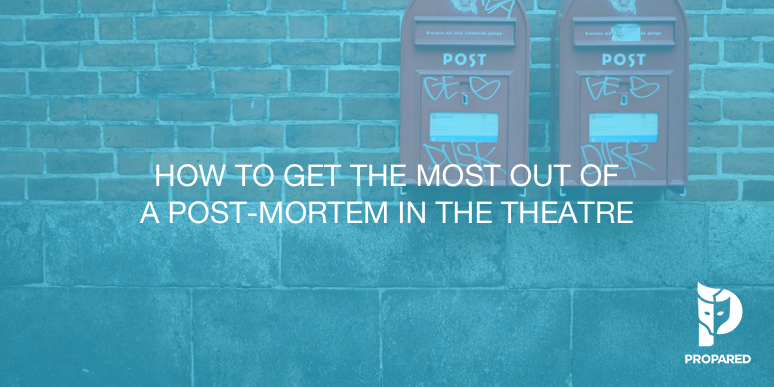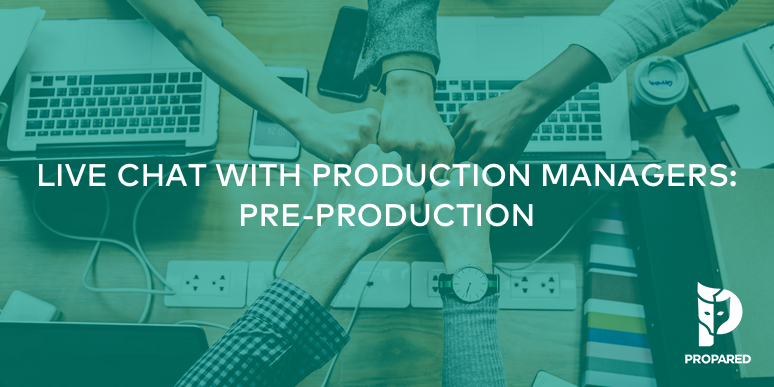
Event planners aren’t perfect. Despite our best efforts and experience, sometimes we screw up. We forget to check parking and delivery street signs near the venue. We underestimate power needs or forget to plan for inclement weather. We recover from most of these mistakes quickly. It might cost some time and money but in the end, the event goes on as planned.
But sometimes, the fix isn’t so easy. Sometimes, the mistake is much bigger. You know what I mean; the game-changing, face-palming, ruin-an-event blunders that make you want to crawl inside a storage closet and stay there for days. If you’ve experienced this feeling before, we feel your pain. We’ve compiled seven of the biggest mistakes we’ve seen and ways you can address them. If you do, we bet you won’t have to go searching for a storage closet anytime soon.
1. Failure to Identify the Real Client
The first thing an event planner needs to determine: the boss. It’s not always the first person you meet. Many companies send low-level reps to deal on their behalf, deliver requirements, or simply get a feel for how you do business. Most of these proxies are quite skilled. They represent their companies well and communicate the vision for an event.
You need to know if they have decision-making authority. If they don’t and they are only acting as an intermediary, you’re willingly playing a game of telephone. Any breakdown in communication could be placed at your feet. Even if it wasn’t your fault. Be direct and ask, “Who’s responsible for signing off on the proposal?” That’s the person (or people) you need to speak with, even if only for a few minutes. It’s in your best interest and the best interest of your contact.
2. Failure to Understand the Client’s Main Goal(s)
Clients often have multiple goals for events. They want to measure attendee engagement, social activity, brand awareness, lead generation and ultimately, revenue growth. Which one (or two or three) take the highest priority? You need to know what he or she wants to accomplish above all else. Failure to do so and you end up paying too much attention to a minor objective. You’ve designed the space to maximize networking but your client wants attendees engaging with vendors.
You’ve got a problem.
Define the metrics for success beforehand and work with your client to translate event goals into data points. Once your KPIs (key performance indicators) have been established, get them in writing for all parties to approve. “We talked about it” is not a sufficient defense. You need a traceable record to back you up when the event is over and you’re in debrief mode.
3. Failure to Do a Proper Walkthrough of the Venue and Event Schedule
We love the cloud. We love email, video conferencing, and using the latest event management technology tools. We should, we make one! We also know there’s no substitute for meeting your client in the venue and walking through the entire event together.
The most beautifully rendered 3-D model still pales in comparison to seeing it in-person. How many clients have you worked with that are experts in Vectorworks? Not many. Virtual walkthroughs are good for giving clients a conceptual understanding. But you want them feel it, not just think it.
Maybe we’re biased; we come from a theatrical background. We view venue walkthroughs as dress rehearsals: they are the closest your client will ever get to understanding the attendee experience. And it’s the last opportunity you’ll have to spot any glaring issues.
4. Failure to Allot Enough Time for Load-In, Set Up, and Load-Out
Here are two real life examples of serious issues, ones that happen more often than they should.
-
The morning of your event, three vendors show up at the same time. The loading dock only has space for one. They all have other jobs after yours and limited time to load-in.
-
You forgot to measure the hallways from the loading dock and there are set pieces waiting outside that won’t fit.
Failure to account for load-in, set-up, and load-out can ruin the best of plans. Some of this can be mitigated with a proper site survey early in the venue selection process. You can make note of any accessibility and operational issues. You’ll have plenty of time during pre-production to engage with your vendors and deliveries and alert them to such complexities.
Get specific estimates. What are your vendors’ expected delivery windows? How long will it take them to set-up? What is the ideal order in which things should get done? Can certain tasks be grouped together?
Whatever estimates you get, plan on adding 50%. If a vendor says one hour, plan for an hour and a half. Better to overestimate and use the extra time for second looks. Communicate often with the venue managerto track any last-minute adjustments or unexpected delays.
One pro-tip that our sister company, Tinc Productions shared with us. Find out what events are booked in the venue before, during (in another space), and after your own. Part of planning is knowing what’s happening around you. You may find ways to cut down loading times or save your client money by creatively partnering with other production managers on equipment.
5. Failure to Create a Contingency Plan
Circumstances sometimes dictate you must resort to plan B. Weather forces a wedding inside. A bad soundboard requires a creative workaround for your presenters. Failing to account for such possibilities can be annoying at best and dangerous at worst. Develop a contingency plan as you build out event requirements. Walk your client through the alternate plan the same way you would the main event.
One important note: contingency plans don’t just mean “alternate” plans. They lay the foundation for the safe harbor and care of your attendees, crew, and performers. A map of emergency exits is a contingency plan. So is a list of nearby hospitals. The well-being of people at your event should be top priority. You don’t want to be the one responsible for another Ghost Ship.
6. Failure to Establish a System to Track Changes
An event schedule will change a thousand times between the day you first create it and the day of the event. Not every change affects every stakeholder. The client probably doesn’t care that you changed the lighting crew call time. But if a vendor has an old version of a schedule with the wrong address, everything could go south in a hurry.
Let’s assume for the moment that you’ve got this type of problem covered. Most event planners we’ve met are meticulous record keepers. The problem lies in volume. We generate mountains of paperwork and endless email threads by making so many changes. More paperwork means more opportunity for someone to miss an important piece of information.
An electrician reading an outdated schedule isn’t technically your fault but again, you’re going to bear the brunt of it. Save yourself the headache by employing a smart, change-tracking system. The best solutions track and push updated information via notification, SMS, or email. Even better, segment and filter your database. If you can create targeted contact lists by department, team, or function, you can communicate changes to only those people affected. This is so much better than sending mass emails. In our experience, blasting the entire team each time a change is made can lead to some grumpy colleagues.
7. Failure to Do a Proper Post-Mortem or Debrief
You are more than a single event; you are a business. The only way to successfully grow your event planning business is to learn from each project. No event is ever perfect. You’ll make mistakes of all sizes. The only way to learn and get better is to solicit feedback from clients, teams, venue managers, and even vendors. In other words, you need to debrief your events.
Reach out to stakeholders. Send thank you notes to crew and volunteers and gently ask about ways you can improve. Make it easy on your respondents. Design questions about your leadership, time management, communication, and conflict resolution and ask them to rate you on a 1-5 scale. Give them the opportunity to provide open-ended feedback but keep it limited. It’s harder to extract common themes if you can’t quantify answers.
Once you collect your response data, put together a personal action list. Pick 2-3 of the most pressing issues and tackle them on your next gig. Commit to long-term improvement. Some mistakes you won’t ever encounter until they happen. Good debrief sessions make sure they won’t happen again.
These are some of the biggest, most gut-wrenching mistakes you can make in event planning. We’ve all probably made one before or come awfully close to the edge. Confronting them head on will help us identify warning signs so we can quickly get back on track. Here’s hoping your next project is a rousing, error-free success!



